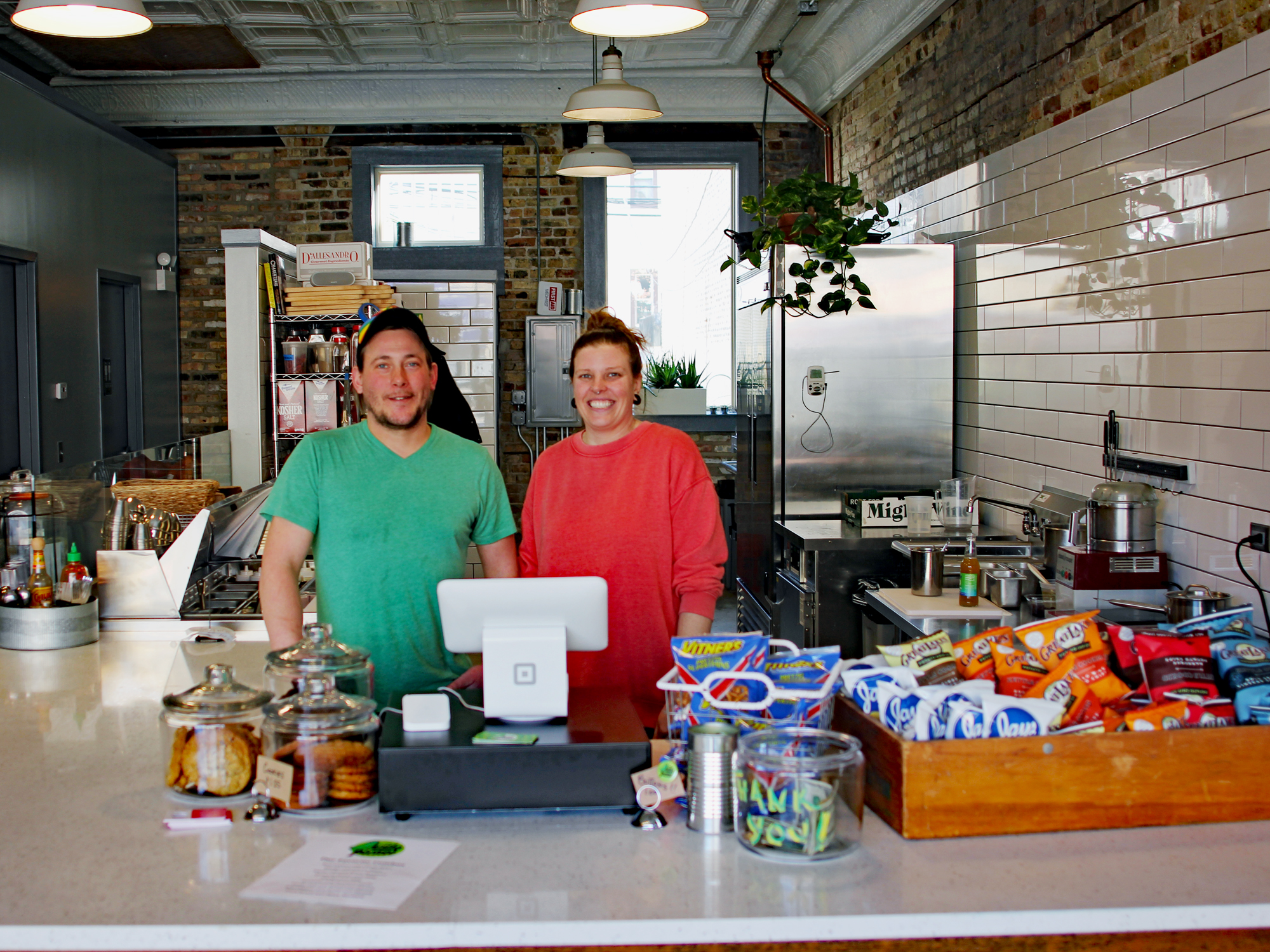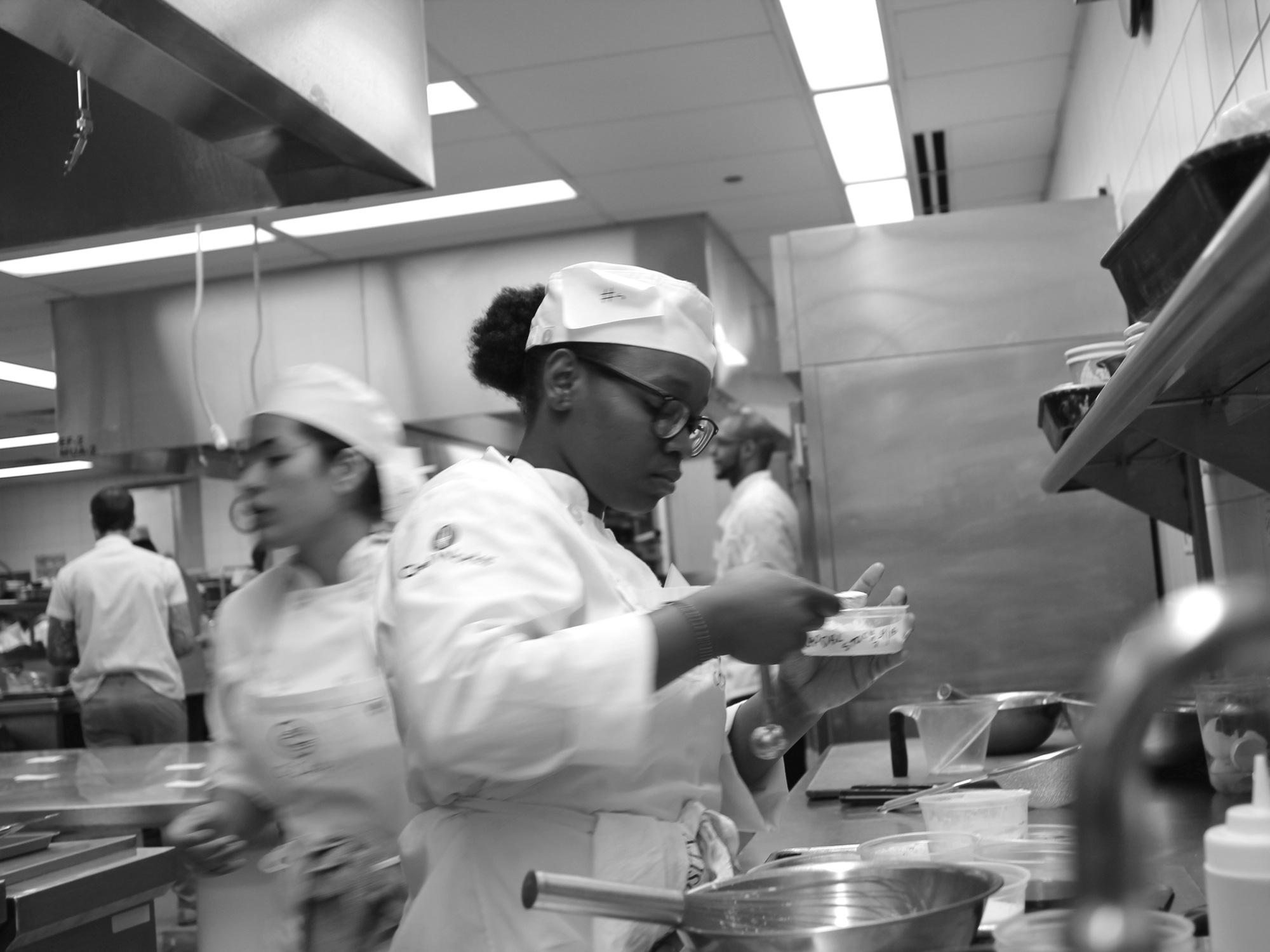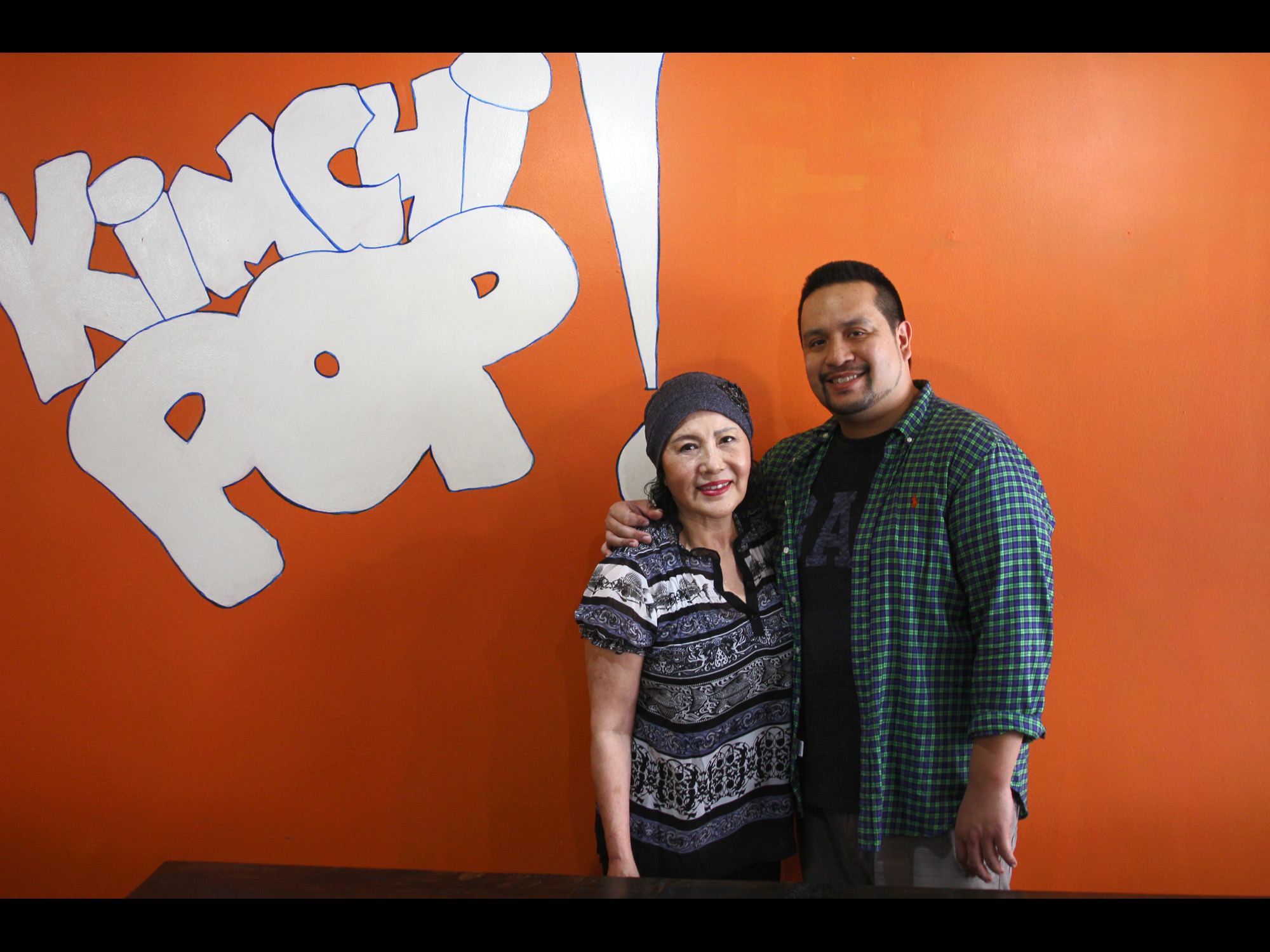PASSEROTTO MEANS “LITTLE SPARROW,” and it comes from a childhood memory—chef-owner Jennifer Kim was pigeontoed when she was a child. “My dad worked all the time, and the only time we’d spend together was right when I went to bed and he’d come in, and turn my foot so I wouldn’t have this janky little foot that keeps turning in. And he’d call me ‘my little sparrow,'” she explains.
It’s a sweet story, and a good way to frame a Korean restaurant built around the flavors you grew up. But notice that, of course, her father would have called her that in Korean—yet the restaurant is named in Italian. Korean is a cuisine that can be a bit secretive—traditional Korean restaurants often have screens in the windows to protect diners’ privacy, and any adventurous eater in Chicago has, at some point, been bewildered by the array of little plates of panchan laid out before them.
So to her mind, she’s using the Italian food that helped her shape her professionally, and is certainly more familiar to Americans, as a way into the Korean food that was part of her life all along.
That, of course, sounds dangerously like the F word, fusion, Asian flavors dumbed down and sweetened up for American palates. She insists it won’t be that. “I feel like the Chicago diner, or really the American diner—they’re willing to try cuisines that they’re not familiar with,” she says. “They’re much more informed, they’re a lot more adventurous than a lot of restaurateurs may think.” At least, that’s the premise she’s going to test—in a location in Andersonville that has been a lot of restaurants over the last decade.
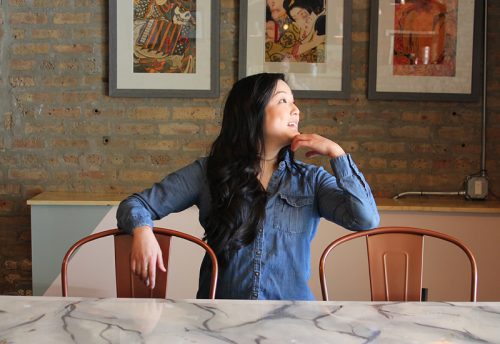
IF YOU KNOW JENNIFER KIM’S NAME—and are not confusing her with Jenny Kim, wife and partner of chef Edward Kim of Mott Street—it’s not for any of the big restaurants she’s worked in but for the smallest, Snaggletooth. Short-lived, much-loved, the seafood-focused artisan deli in Lakeview was where she and her then-boyfriend Bill Montagne landed after a semi-disastrous less-than-a-year at a now-closed downtown high roller spot called C Chicago.
They went from scapegoats to heroes once word went around of the exquisitely cured fish and the sweet, serene atmosphere of the tiny place, decorated with pictures of Buster Keaton and David Bowie that Kim scavenged from her own apartment. Their comeback was topped off when they jointly won the Jean Banchet Award for Best Rising Chef in early 2017.
The two-person show was built for regrouping, not for the long haul—Kim says, “It was small enough and controllable enough. We learned a lot of great lessons about business and how things run and what to expect.” After about a year and a half, Montagne wound up at Nico Osteria—one of Kim’s former gigs as she moved around the One Off Hospitality restaurants. (They’re no longer a couple but remain friends.) Kim thought for a while about just going back into a big restaurant—”Maybe that’s where my life is headed,” she says she thought—but her idea of how to do Korean food for an open-minded non-Korean audience stuck with her.
At first they were like, ‘Oh, well, we don’t know if you’re Korean enough to cook Korean food.’ Which is really weird coming from your parents!
“I’ve always sort of had this concept, of doing Korean food, or at least the Korean food that I grew up with,” she explains. “I approached [an investor] maybe two or three years ago, before we did Snaggletooth, but it was hard to find people who thought this was a great idea. There was always that ‘if’—if it’s not just Korean food, if it’s Korean-American food. This was going to be the ultimate passion project for me, I didn’t want it to get watered down.”
While she was trying to decide what direction she should take, she met with Diana Davila, who had just opened Mi Tocaya Antojeria. “I just wanted to get her perspective—what did it take to go out on your own, completely alone, and then open your own dream?”
Davila pointed her to Stephan Outrequin Quaisser, whose LM Restaurant Group is involved with several smaller restaurants around the city including Mi Tocaya, Bistronomic and Troquet. “He’s very much like, in order for the restaurant to be successful, the concept needs to be 100% yours, the food needs to be 100% yours. He’s really just here as support, because he’s done this before,” Kim says.

What Outrequin Quaisser also offered her was an existing restaurant space—one that, after a successful run as the wine bar In Fine Spirits, had seen a number of concepts come and go: Premise, Taverna 750, LM group’s own Brasserie 54, and The Brixton. Kim is trying to apply lessons from previous experience in the space. For one, she said no to renting an upstairs space, which various previous tenants had tried unsuccessfully to make effective use of. “I’m happy with this, this is three or four times the size of Snaggletooth,” she says of the first floor space she’s using.
The bar, which has been a feature of the space as long as anyone can remember (maybe this far), presents another problem—it implies a neighborhood tavern, which worked for In Fine Spirits and The Brixton, but proved a disconnect for Premise’s modernist food. “I’m 34 years old, I just want to go to bed at 11 or 12 at night, I can’t be up till 2 or 4 in the morning managing a bar, goodness gracious no,” Kim says, settling any question of being a drinking hole. Instead, she cut the actual bar service area in half, and turned the end of it into a two sided communal table with eight seats (a bit like the one that extends from the bar at Parachute). The once-dark bar is now well-lit, cheerfully decorated (a different Bowie artwork this time), and ready to open at the beginning of May.
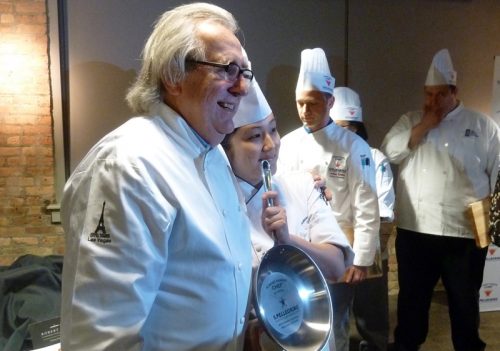
Chef Jean Joho congratulates Jennifer Kim on winning the S. Pellegrino Young Chefs regionals at Kendall College, 2012
“I WAS A CAREER CHANGER—I went to UIC for pharmacy,” she explains when I ask her how she got into food. “We did one of those job shadow programs over the summer where you work at a Walgreen’s or an Osco. And I just remember following the pharm tech around, and thinking, I don’t know that I could do this the rest of my life. I loved the learning aspect of it, like learning what happens when this interacts with this, but the real world application of it….”
From the interactions of medicine to the interaction of ingredients seems a logical enough step. Though she says, “I love the science behind cooking, and the application process of it, but it took me a while to get there. From my mid-20s I was just like, I’m going to drift around until I get to what I really enjoyed doing. Cooking re-sparked those things that I enjoyed in my pharmacy studies. There’s so much more to cooking, than just cooking.”
She has enough of the dutiful Korean daughter that it’s hard to imagine her rebel phase going too wild. In any case, she signed up for cooking classes at a community college, and dedication quickly kicked in—”I enrolled in Kendall College and never looked back.” In 2012 she competed in the regional S. Pellegrino Young Chefs Challenge. The judges, who included Chef Jean Joho (Everest), Chef Joncarl Lachman (Vincent), and the then-writer for Grub Street Chicago, one Michael Gebert, selected her to go on to the national competition—which she won later that year in Napa.
Which must have been reassuring for the parents who had watched her drop out of a Korean-parents-approved career in medicine a few years earlier. “My parents immigrated here in the 70s, and I was born here,” she says, growing up near Schaumburg. “As a child of immigrants, you kind of have this weird duality of, am I Korean, am I American, sometimes you don’t feel Korean enough, sometimes you don’t feel American—you’re in this interesting little area, floating and trying to figure out where you belong.
“Growing up you’re eating Korean food, you’re in Korean school, my parents were trying to immerse me in Korean culture,” she says. “They didn’t want me to lose that part of yourself. But then you go through your phase as a teenager, saying, I don’t fit in if I’m just Korean. I need to be way more American. You’re doing these big jumps back and forth.”
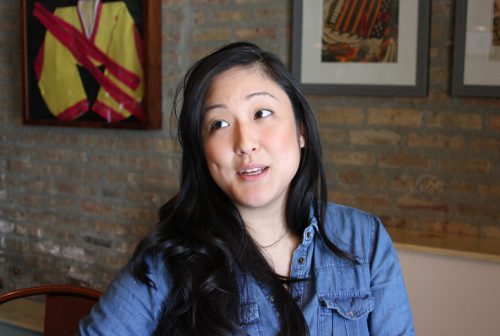
Culinary school took her further from her roots—to French technique—and it wasn’t until she was interning at Blackbird (while still at Kendall) that she saw a path back to them. “That was when David Posey had just started, so that was a whole different type of cooking—it was still technique-based, but there were all these Scandinavian influences from his background,” she says. “It was such an interesting thing to see all these different aspects of cooking and culture, and how that affects the food that you make.”
Koreans, in particular, have had a problem with finding acceptance of their food culture in America—a problem summed up by kimchi, the spicy fermented cabbage as ubiquitous in Korean food as white bread in this country. “When I was little, my mom packed me a Korean lunch and I opened it and all the kids are like, ‘Ooooh! This is so gross, what is that! It smells so bad!'” she says. “I was just mortified, and I closed my lunch and I went home and gave it to my mom and said, you need to start packing me ham sandwiches. It made me feel shameful, that I was so different.”
She gives credit to her years working at different One Off restaurants for helping her to accept her heritage. “Paul Kahan is so open-minded culturally, ‘Hey, let’s take influences that are meaningful and impart them into food.’ The two years that I spent at Nico were impactful. We were doing Italian food, but still very much interpreted by the chef and who’s working there. It helped me get to the point where I could think, it’s okay for me to do Korean food that isn’t Cho Sun Ok or San Soo Gab San, that isn’t Korean barbecue.”

“WHEN I FIRST CAME UP WITH the concept of doing Korean food, for me, there was always a love of Italian food,” Kim says. “And so it has influences within what we’re cooking, but it is in no way a Korean-Italian restaurant.”
I wait to see what this means. “It’s kind of like bridging the gap. They’re two very different cuisines, they’re two very different types of cultures, but there are these connective things that are like the bridges that connect these two very different cuisines. It’s like the influences that it’s had.”
Influences on who? “On me,” she says at first. “But if you look at Korean food in Korea, there’s definitely the influences of other cuisines. Though that’s more in the bigger cities, like Seoul or Busan. When my grandmother was still alive, she lived in what was essentially an onion village. They grew onions, and all the farm animals ate onions, and so they’re still very much traditional. But Korean people are very open to exploring other cultures, and seeing how that ties in with their own.”
She’s getting warmed up now. “What does it mean to be traditional or authentic? We have it in our mind that Korean needs to be these things, Italian food needs to be things, that’s the parameter. Yet there are so many Chinese influences, so many Japanese influences on Korean food. And especially living in the U.S. with so many different influences, our idea of ‘traditional’ needs to change with the times.”
So what does that mean for diners? How will they see it on the plate? “There are definitely influences of Italian cuisine—there may be things on the menu that they read and they say, ‘Oh, I know what tortelloni is, I know what a ragu is.’ It’s not like the ragu that an Italian grandmother makes, it’s Korean-based, it’s more like a stew. It’s just kind of a nice way for people to recognize things, where if it says dukbokki, I don’t know what that is, I don’t know what to expect.”
Okay, so it’s a menu aid. Is there something more to it—some deeper connection to the way Italians eat, the way Italian food spoke to her?
“I was talking with my parents about doing this restaurant,” she says. “At first they were like, ‘Oh, well, we don’t know if you’re Korean enough to cook Korean food.’ Which is really weird coming from your parents!” she laughs. “But I understand, the food that I grew up with is very different than what they grew up with, living in Korea, in small towns where they didn’t know anything else. That’s what they think of as Korean food—or Cho Sun Ok or San Soo Gab San.
“I think for my parents, they came here in the 70s, and the Vietnam War was going on—it wasn’t a great political environment for them. There were little stigmas around being Asian. Nobody wanted to touch kimchi. I showed my mom something in Bon Appetit about gochujang. ‘Look, mom, this is in a publication that is read nationwide, and they’re talking about Korean products. They’re talking about how to make kimchi. People are a lot more open-minded now than they were 30, 40 years ago.
“But the older generation—they don’t get it. They go into Cho Sun Ok and they’re like, [whispers] ‘what are all these white people doing here?’ They like Korean food! Get over it, guys! My mom is still like, ‘Are you sure this is the right thing to do?’ I want to show them that it is something that is embraced. I think that’s the validation they need, to finally let go of forty years of acting like ‘people don’t like us.'”

She doesn’t really directly answer the question, but I get it. Everybody loves Italian food. Italian families are what we think of when we think of a big feast with the whole family around the table. She grew up with Korean taste memories, but she responded to how Italian food was accepted by the mainstream culture, how it came to stand for things we mostly didn’t have any more in our busy lives. She saw how making Italian food for somebody was a gift of love. At Passerotto, she wants to serve you a big Italian feast—of Korean food.
Michael Gebert likes both Korean and Italian food as editor of Fooditor, why wouldn’t you?
Latest
Join the Discussion
After you comment, click Post. If you're not already logged in you will be asked to log in or register with Disqus.





